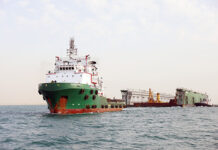
Over the past weekend, CMA CGM Scandola marked the inaugural call of an LNG-powered vessel at the Port of Koper in Slovenia.
This 15,000 TEU container ship, owned by the French shipping company CMA CGM, signifies a notable stride towards adopting more environmentally responsible practices and gradually curbing CO2 emissions.
During this event, Gregor Belič, a member of the Management Board of the Port of Koper, and Bine Štancar, the general manager of the CMA CGM Adriatic Cluster, visited the ship.
CMA CGM Scandola is among the 35 vessels in the fleet of the Marseille-based ocean carrier powered by liquefied natural gas (LNG). By the year 2028, it is anticipated that the count of ships fueled by decarbonized sources will rise to 120, resulting in a potential decrease of up to 20% in CO2 emissions compared to ships relying on fossil fuels.
This strategic move is aligned with the ship owner’s pledge to attain net zero emissions or climate neutrality by 2050. Furthermore, it aims to significantly mitigate emissions across the entire logistics group in the preceding years leading up to this target.
“The arrival of the CMA CGM Scandola demonstrates our commitment to reducing our carbon footprint and to adopting more environmentally friendly forms of transport and logistics,” stated Bine Štancar, general manager of the CMA CGM Adriatic Cluster.
The adoption of LNG as a propulsion source in maritime transportation is presently regarded as one of the most promising and effective alternative energy solutions. It plays a crucial role in mitigating the adverse environmental effects of maritime transport and safeguarding air quality. By utilizing LNG fuel, it is anticipated that emissions of sulphur oxide (SOx) could be reduced by up to 99%, particulate matter (PM) emissions by 91%, and nitrogen oxide (NOx) emissions by 92%, both during voyages and as localized emissions when ships are docked in ports.
“We are pleased that CMA CGM’s objectives are in line with the sustainable development strategy of the Port of Koper, which is based on maintaining environmental sustainability standards, reducing the Company’s carbon footprint and increasing energy self-sufficiency through renewable energy sources. In addition, for many years now, we at the Port of Koper have been working to involve shipowners in activities to reduce environmental burdens. This is why we have recently introduced the Environmental Ship Index (ESI) scheme, which is also used by other ports to incentivise and reward cleaner ships,” commented Gregor Belič, a member of the Management Board, adding that ships that meet several environmental criteria to reduce their environmental impact are already able to pay lower port charges. This is one of the key comparative advantages of the ports included in the ESI scheme.





